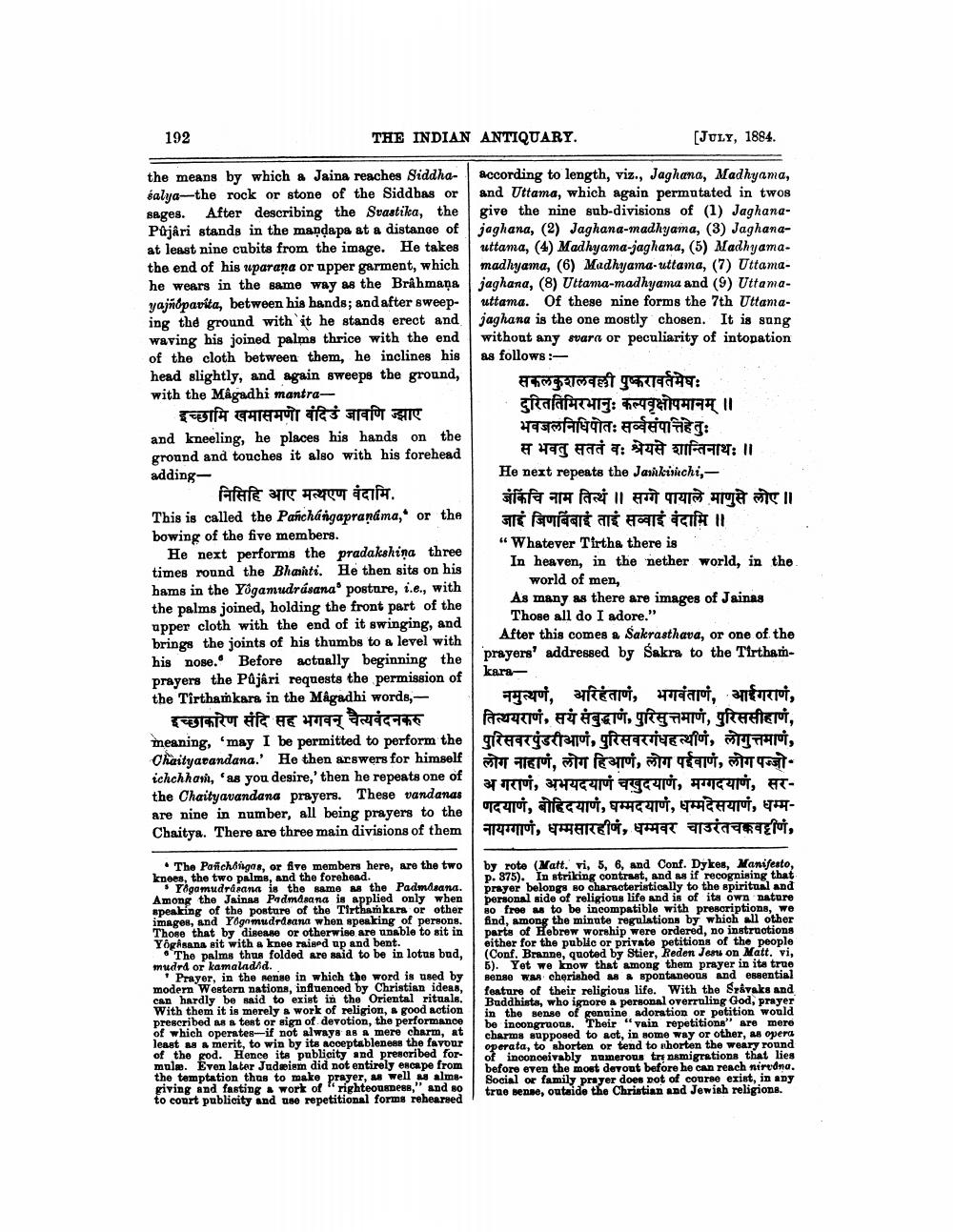________________
192
THE INDIAN ANTIQUARY.
the means by which a Jaina reaches Siddhaéalya-the rock or stone of the Siddhas or sages. After describing the Svastika, the Půjâri stands in the mandapa at a distance of at least nine cubits from the image. He takes the end of his uparana or upper garment, which he wears in the same way as the Brahmana yajnopavita, between his hands; and after sweeping the ground with it he stands erect and waving his joined palms thrice with the end of the cloth between them, he inclines his head slightly, and again sweeps the ground, with the Mâgadhi mantra
इच्छामि खमासमणी बंदिउं जावणि ज्झाए
and kneeling, he places his hands on the ground and touches it also with his forehead adding
निसिहि आए मत्थरण वंदामि.
This is called the Panchangapranáma, or the bowing of the five members.
He next performs the pradakshina three times round the Bhaiti. He then sits on his hams in the Yogamudrásana posture, i.e., with the palms joined, holding the front part of the upper cloth with the end of it swinging, and brings the joints of his thumbs to a level with his nose. Before actually beginning the prayers the Pujari requests the permission of the Tirthamkara in the Magadhi words,
इच्छाकारण संदि सह भगवन् चैत्यवंदनकरू meaning, 'may I be permitted to perform the haityanandana Ho then acswers for himself ichchham, as you desire,' then he repeats one of the Chaityavandana prayers. These vandanas _are_nine in number, all being prayers to the Chaitya. There are three main divisions of them
[JULY, 1884.
according to length, viz., Jaghana, Madhyama, and Uttama, which again permutated in twos give the nine sub-divisions of (1) Jaghanajaghana, (2) Jaghana-madhyama, (3) Jaghanauttama, (4) Madhyama-jaghana, (5) Madhyamamadhyama, (6) Madhyama-uttama, (7) Uttamajaghana, (8) Uttama-madhyama and (9) Uttamauttama. Of these nine forms the 7th Uttamajaghana is the one mostly chosen. It is sung without any svara or peculiarity of intonation as follows:
The Panchongas, or five members here, are the two knees, the two palms, and the forehead.
Yogamudrasana is the same as the Padmasana. Among the Jainas Padmasana is applied only when speaking of the posture of the Tirthamkara or other images, and Yogamudrasana when speaking of persons. Those that by disease or otherwise are unable to sit in Yogasana sit with a knee raised up and bent.
The palms thus folded are said to be in lotus bud, mudra or kamaladid.
Prayer, in the sense in which the word is used by modern Western nations, influenced by Christian ideas, can hardly be said to exist in the Oriental rituals. With them it is merely a work of religion, a good action prescribed as a test or sign of devotion, the performance of which operates-if not always as a mere charm, at least as a merit, to win by its acceptableness the favour of the god. Hence its publicity and prescribed formula. Even later Judaism did not entirely escape from the temptation thus to make prayer, as well as almsgiving and fasting a work of "righteousness," and so to court publicity and use repetitional forms rehearsed
सकलकुशलवली पुष्करावर्तमेघः दुरिततिमिरभानुः कल्पवृक्षोपमानम् ॥ भजलनिधिपोतः सर्व्वसंपातहेतुः
स भवतु सततं वः श्रेयसे शान्तिनाथः ॥
He next repeats the Jamkinchi,किंचि नाम तिन्यं ॥ सग्गे पायाले माणुसे लोए ॥ जाई जिणबिंबाई ताई सव्वाई वंदामि ॥ "Whatever Tirtha there is
In heaven, in the nether world, in the world of men,
As many as there are images of Jainas Those all do I adore."
After this comes a Sakrasthava, or one of the prayers' addressed by Sakra to the Tirtham
kara
ममुत्यर्ण, अरिहंताणं, भगवंताणं, आईगराणं, तित्ययराणं सर्व संबुद्धाणं, पुरिसुत्तमाणं, पुरिससीहाणं, पुरिसवरपुंडरीभाणं, पुरिसवरगंधहत्यगं लोगुत्तमार्ण, लोग नाहाणं, लोग हिआणं, लोग पईवाणं, लोग पड़ो अ गराणं, अभयदयाणं चखुदयाणं, मग्गदयाणं, सरणदयाणं, बोहिदयाणं, घम्मदयाणं, धम्मदेसयाणं, धम्मनायग्गाणं, धम्मसारहीणं, धम्मवर चाउरंतचकवट्टीणं,
by rote (Matt. vi, 5, 6, and Conf. Dykes, Manifesto, p. 375). In striking contrast, and as if recognising that prayer belongs so characteristically to the spiritual and personal side of religious life and is of its own nature 80 free as to be incompatible with prescriptions, we find, among the minute regulations by which all other parts of Hebrew worship were ordered, no instructions either for the public or private petitions of the people (Conf. Branne, quoted by Stier, Reden Jesu on Matt. vi, 5). Yet we know that among them prayer in its true sense was cherished as a spontaneous and essential feature of their religious life. With the Sravaks and Buddhists, who ignore a personal overruling God, prayer in the sense of genuine adoration or petition would be incongruous. Their "vain repetitions" are mere charms supposed to act, in some way or other, as opera operata, to shorten or tend to shorten the weary round of inconceivably numerous tre nsmigrations that lies before even the most devout before he can reach nirvana. Social or family prayer does not of course exist, in any true sense, outside the Christian and Jewish religions.




